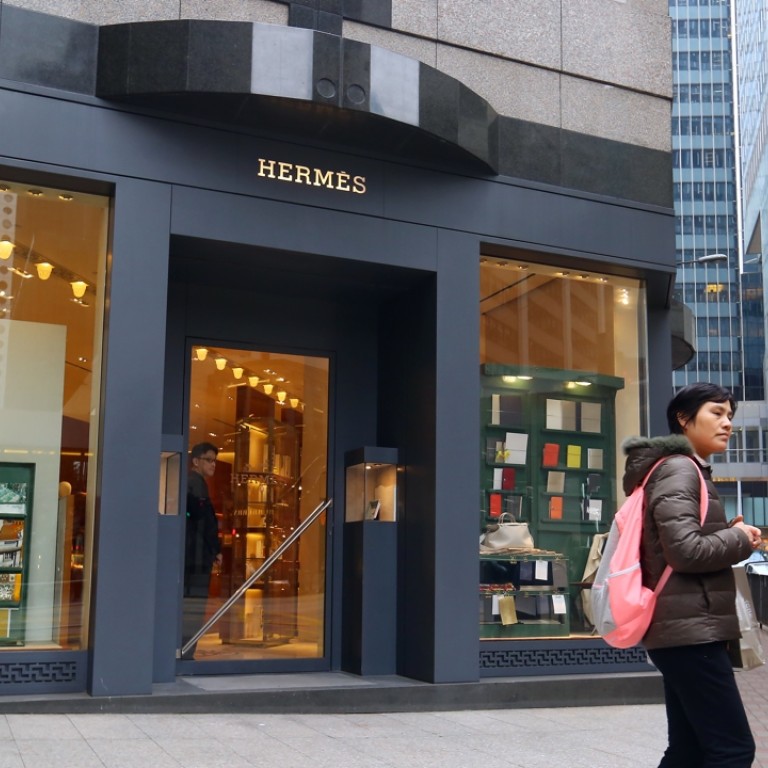
Hermes relocating to Prince’s Building amid talk it plans to sell flagship store for HK$1.5 billion
International luxury brand bought shop at The Galleria for HK$190 million 14 years ago
International luxury brand Hermes will relocate to Prince’s Building, in Central, a move suggesting it plans to sell its flagship store at The Galleria at 9 Queen’s Road Central amid sluggish sales of luxury goods.
Hermes Asia Pacific told the South China Morning Post on Wednesday it had “just signed a contract with Hongkong Land for relocation of the brand’s flagship store in Prince’s Building”.
“It is a significant investment which proves Hermes’ confidence in the local retail market,” it said.
Although Hermes did not reveal more details, industry insiders say it may replace three existing Prince’s Building tenants – Alfred Dunhill, Ralph Lauren and Brooks Brothers – which occupy a total of more than 10,000 sq ft.
Hermes is likely to open the new store at Prince’s Building next year or in 2018, with the existing tenants’ leases due to expire over the course of next two years.
Prince’s Building’s ground floor also accommodates other world-famous fashion and specialty stores, including Cartier, Chanel and Van Cleef & Arpels.
Industry insiders said the relocation plan suggested Hermes was considering selling its 7,500 sq ft flagship store at The Galleria, for which it paid HK$190 million in 2002.
It may be the first ground-level retail shop put on sale in nearly a decade
“Globally, Hermes does not own properties except Paris and Hong Kong,” one source said. “The sale in Hong Kong is probably the result of aiming to cash in after seeing huge capital appreciation of the retail property rather than concern about poor retail market sentiment.”
Hermes is offering the flagship store at an indicative price of HK$1.5 billion, or HK$200,000 per square foot, according to the Chinese-language Hong Kong Economic Times newspaper.
If the retailer managed to realise a sale for HK$1.5 billion, it would reap a gross profit of HK$1.3 billion within 14 years.
“It may be the first ground-level retail shop put on sale in nearly a decade,” said Michael Chik, managing director of agency Sheraton Valuers.“This transaction will serve as a benchmark in the market.”
International brands which paid ultra-high rents in 2008 are surrendering space as fewer mainland tourists visit Hong Kong amid Beijing’s anti-corruption drive, which discourages spending on luxury items.
In September, bag and accessory retailer Coach closed its 13,000 sq ft flagship store in Central, citing high rent and a falling number of mainland tourists.
Coach was charged a penalty of HK$130 million after it decided to terminate the lease two years ahead of the October 2017 expiry.
The shop is now occupied by sports brand Adidas at a rent of about HK$5 million a month, plus the cost of the advertising billboard, about 28 per cent cheaper than the HK$7 million Coach had been paying since 2008.
“Under the current sluggish retail market, I would not be surprised to see more luxury brands either retreating or surrendering their spaces in the wake of declining sales,” Chik said.
Central’s retail shops had been nearly fully let, but Chik said he had recently spotted some vacant stores available for leasing. Lanvin did not renew the lease for its 800 sq ft ground-level shop plus 7,000 sq ft of mezzanine space at New Henry Building, just opposite The Galleria, and the landlord was now open to all offers.
In Causeway Bay, fast fashion chain Forever 21 was in talks with potential tenants to take up its space at Capitol Centre, for which it was paying a jaw-dropping HK$11 million a month, he said.
Joe Lin, executive director of retail services at leasing firm CBRE, said some mid-scale overseas brands planned to expand into Hong Kong to take advantage of lower retail rents.

